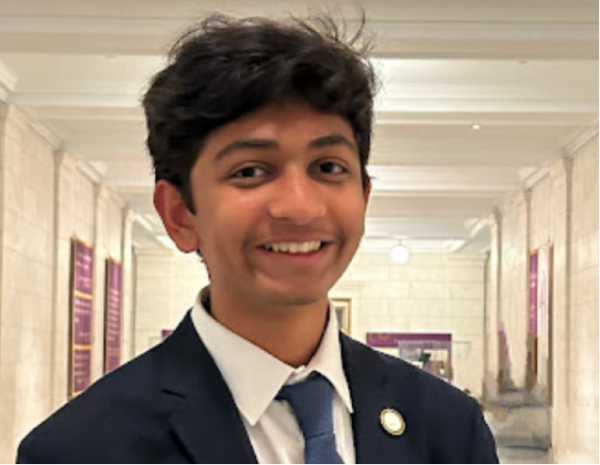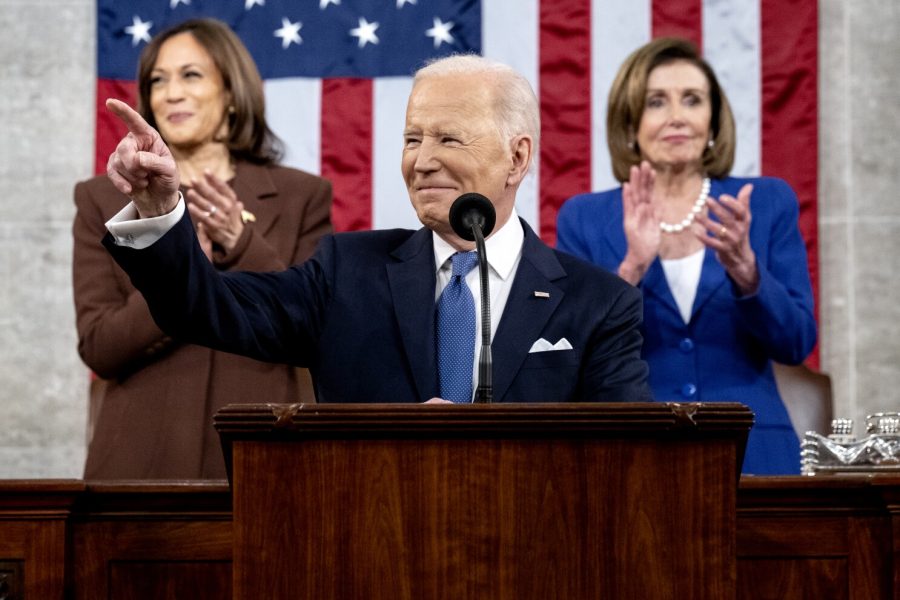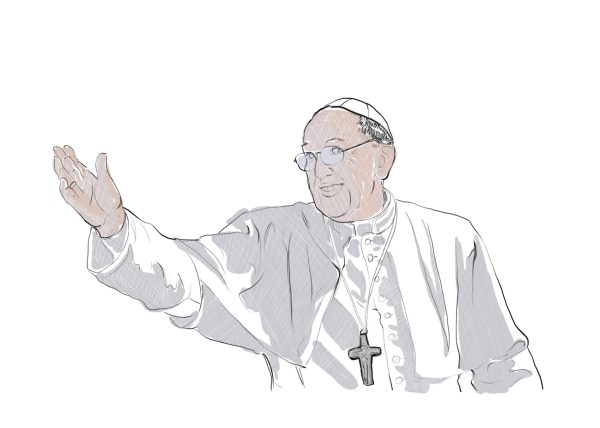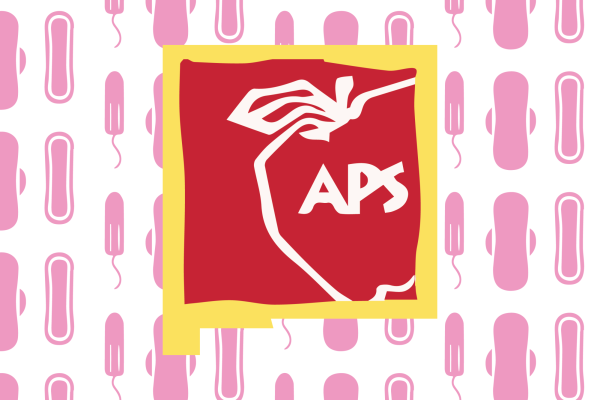Biden Delivers Second State of the Union Address
First since Republicans take back control of the House
On Tuesday, February 7, President Biden delivered his second State of the Union address, his first following last year’s midterm elections, when Democrats were able to expand their majority in the Senate, while Republicans narrowly clinched control of the House of Representatives. The President covered a variety of topics, ranging from healthcare to infrastructure and the war in Ukraine, but it was an exchange with a group of rowdy House Republicans that caught everyone’s attention.
Tuesday’s address was the first time Biden stood before Congress with newly-elected House Speaker Kevin McCarthy seated behind him, alongside Vice President Kamala Harris. His presence was symbolic, given that Democrats no longer control all levers of power in Washington, meaning that President Biden will likely have a substantially more difficult time passing his agenda through a divided Congress. However, Biden had plenty of accomplishments from the previous Congress to tout, some symbolized by members of the audience. His cabinet, who have barnstormed the country in recent weeks to promote different planks of his agenda, were seated in front of him, while his newly-appointed Supreme Court Justice, Ketanji Brown Jackson, was also in attendance. Additionally, seated in the upstairs gallery with First Lady Dr. Jill Biden were various individuals who would benefit from the legislation passed under the Biden administration, including ironworkers, students, and patients.
The President started off his speech with a nod to McCarthy, congratulating him on his new position, while also recognizing Senate Minority Leader Mitch McConnell, Senate Majority Leader Chuck Schumer, and former Speaker Nancy Pelosi, who he titled “the greatest Speaker in the history of the House” to a large standing ovation.
After this, the President entered a phase of his speech where he listed his administration’s accomplishments. First, he stated the fact that 12 million new jobs have been created since he took office. He also cited low unemployment and record small business creation as signs of a rebounding economy, while addressing concerns about inflation by saying that “we have more to do,” but that it is on its way down. In a tribute to his Vice President, he thanked her for her role in leading the administration’s efforts to boost small businesses, especially in communities of color, signaling that the bond between the two leaders remains strong as they plan to announce their re-election bid in the near future. While stating these numbers, the President received raucous applause from all Democrats and a handful of Republicans. But the vast majority of Republicans, including the Speaker of the House, stayed silently seated, signaling the Capitol’s partisan divides.
The President then moved on to talking about the pieces of his economic agenda that were passed by Congress over the last year. He mentioned the Bipartisan CHIPS and Science Act, which invested billions of dollars into revitalizing the American semiconductor industry (whose shortage of production was blamed as a prime factor of rampant inflation, especially in the prices of automobiles), which is expected to create thousands of jobs in new factories across the country. Then, he moved on to the bipartisan infrastructure law, the biggest investment in America’s roads, bridges, highways, broadband, and clean water systems since President Eisehower’s interstate highway program. In this section of the speech, he also mentioned other recently-passed major bipartisan legislation, including the Respect for Marriage Act (which codified the right to marry someone of the same sex or a different race), and the Electoral Count Reform Act (which made it harder to object to the certification of a presidential election, like what happened on January 6th, 2021). The President has long made it a point to highlight his bipartisan achievements, saying in his address that “fighting for the sake of fighting, conflict for the sake of conflict, and power for the sake of power gets us nowhere,” expressing a desire to continue working with Republicans over the next two years.
Moving on from his bipartisan accomplishments, the President moved on to an achievement passed by only Democrats in Congress: the Inflation Reduction Act. The law was the largest investment in the climate crisis in American history. On that topic, Biden noted that the climate crisis is an “existential threat,” and that the plan would establish tax credits to purchase electric appliances and vehicles and help to weatherize homes against dangerous storms. To loud applause (on the Democrat side of the chamber), Biden reminded viewers of one of the longest-sought provisions of the Inflation Reduction Act – a cap on the cost of insulin for seniors on Medicare, in addition to new rules that allow Medicare to lower prescription drug prices. After Republicans sarcastically cheered when Biden mentioned some of their efforts to repeal the act, Biden emphasized that “if you [Congress] do anything to raise the cost of prescription drugs, I will veto it.” Lastly, the President ended the healthcare section of his speech by noting that a record number of Americans had signed up for health insurance provided by the Affordable Care Act, which was recently expanded by the Inflation Reduction Act. He went on to describe the tax provisions used to pay for the bill, including a new minimum tax for the country’s largest corporations who, up until now, have sometimes paid zero dollars in federal taxes. This section of the speech was met with great enthusiasm from progressives, like Senator Elizabeth Warren of Massachusetts, a former presidential candidate who had led the Democrats’ efforts to raise taxes on the wealthy.
However, the most contentious part of the speech came next: when the President condemned efforts, like those of Senator Rick Scott of Florida, to “sunset” (forcing continual votes on) all federal legislation every four years, including Social Security and Medicare, putting those programs at risk. The President also warned against Republican efforts to use those programs as bargaining chips in the ongoing federal budget negotiations, saying that he would oppose any cuts to those services. Almost immediately after the President mentioned the topic, Republicans threw the chamber into chaos, screaming, booing, jumping onto their feet, and pointing at the President. Representative Marjorie Taylor Greene of Georgia even called the president a “liar” on multiple occasions, so loudly that the House Speaker made an attempt to quiet her down. The president quickly shot back, saying that he loves “conversion” (he claimed credit for converting many Republicans into ardent defenders of Social Security on the spot) and that “unanimity” had been achieved in getting Republicans to say on the record that they opposed cuts to Medicare and Social Security, in a way revealing that they had fallen into his trap of publicly expressing support for those programs, making it far more difficult for Republicans to attempt to jam through any type of spending cuts into the budget negotiations. But most notably, the president did not seem caught off guard. Rather, he seemed genuinely happy, and seemed to revel in the discord, given that it fits right into one of his main goals for the speech – to provide a contrast between himself and the Republican Party. And, through those heckles, those Republican representatives became props for the very president they were trying to drown out.
After this, the president moved quickly through a range of issues he aimed to tackle in the second half of his speech. On the topic of high costs, the President detailed a list of measures his administration had already taken to slash so-called “junk fees,” surprise payments that airlines, hotels and rental car companies sometimes levy on consumers after they have already made initial reservations. This was part of the president’s larger plan to reduce costs where possible as inflation has made many aspects of life – especially travel – significantly more expensive. Next on his agenda was the COVID-19 pandemic. The fact that the virus was so far into his speech was a testament to the progress made in the fight against the disease, signaling, as the President put it, that “COVID no longer controls our lives.” He credited historic advances in medicine with the progress, though he acknowledged the loss felt by the families of more than a million Americans who have perished during the pandemic while cautioning that Americans should still stay vigilant due to the threat of future variants.
Biden also called on Congress to act on several pieces of his agenda which have not been able to get passed so far due to Republican opposition, and are unlikely to see progress in the near future. For instance, he pushed for Congress to codify the right to receive an abortion, as well as legislate greater safeguards for LGBTQ Americans who experience discrimination or violence. He also asked Republicans to work with his administration on the issue of immigration, reaffirming his commitment to securing the border, while giving immigrants a pathway to citizenship.
But two of his calls to action stood out, both related to public safety. Two of the First Lady’s guests were the parents of Tyre Nichols, a young and unarmed Black man beaten to death by police officers in Memphis, Tennessee last month. When Biden mentioned their presence, almost all of the audience rose in a standing ovation. Following their introduction, Biden pressed for greater safeguards on the amount of excessive force used by police officers, including through the passage of the George Floyd Justice in Policing Act, drafted in the wake of its namesake’s killing. When he moved to the issue of gun violence, Biden acknowledged another audience member in the First Lady’s gallery, Brandon Tsay, who saved perhaps dozens of lives when he grabbed a gun out of the hands of a mass shooter, who, just a few weeks ago, killed several Lunar New Year celebrators in Monterey Park, California. While the President thanked members of Congress for passing a modest gun control package last summer – which drew bipartisan applause led by the bill’s author, Independent Senator Kyrsten Sinema – he used Tsay’s story as a plea for Congress to enact greater gun control measures, including an assault weapons ban and universal background checks.
In the penultimate phase of his speech, Biden followed up on the “unity agenda” he laid out in last year’s State of the Union address, which was focused on assisting veterans exposed to toxic burn pits, working on the issue of gun safety and mass shootings in America, and individuals impacted by devastating cancers. On all of those fronts, Congress has passed legislation over the past year to address those concerns, including the Sergeant Heath Robinson PACT Act, the biggest expansion to veterans’ healthcare access in nearly three decades, the Bipartisan Safer Communities Act, the modest gun control package which also included an expansion to school mental health services, and President Biden’s cancer moonshot research program, which aims to cut cancer deaths in half by 2050. The president asked Congress to continue working to advance these heavily bipartisan goals in the coming months.
Lastly, the President rounded out his speech with an emphasis on protecting democracy, at home and overseas. After pointing out that the Ukrainian Ambassador to the United States, Oksana Makrova, was in attendance, the President highlighted the billions of dollars in aid that the United States has given Ukraine in their fight against Russian aggression, reaffirming his commitment to Ukrainian sovereignty. More broadly, the President expressed his desire for the continuation of the tight Western unity which has emerged from the Russian invasion, pressing allies to continue to side with the U.S. in its efforts to limit not only Russian but also Chinese, efforts to expand their hegemonies. Turning to democracy at home, the President discussed the persistent threat of political violence that has remained a presence in American politics since the January, 6th, 2021 attack on the U.S. Capitol, and which further exposed itself during an October 2022 attack on Paul Pelosi, the husband of the then-Speaker of the House. Pelosi was with the First Lady that evening and was used by Biden as an example of courage and resilience in the face of the increasingly dangerous political divisions facing the country.
All in all, the President entered the address with three main goals: to sell the accomplishments of the last two years, present an energetic and optimistic persona, and show a contrast between himself and the Republican Party in temperament and behavior. And, from the looks of it, the President has achieved all three of those goals, giving him a crucial political boost ahead of his expected re-election bid, which will likely launch in the coming weeks. A CNN flash poll showed most viewers agreed, with 72% of Americans who tuned in reacting positively to it.

Abhishek is a deeply engaged member of the Albuquerque Academy community, part of several government and politics-focused clubs and activities. For the...







